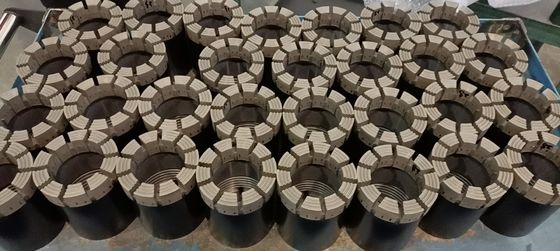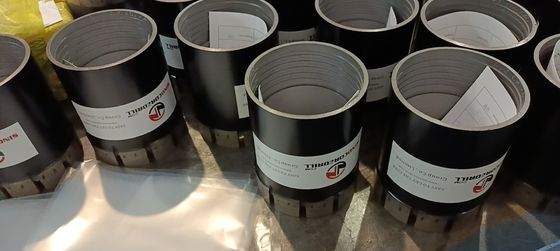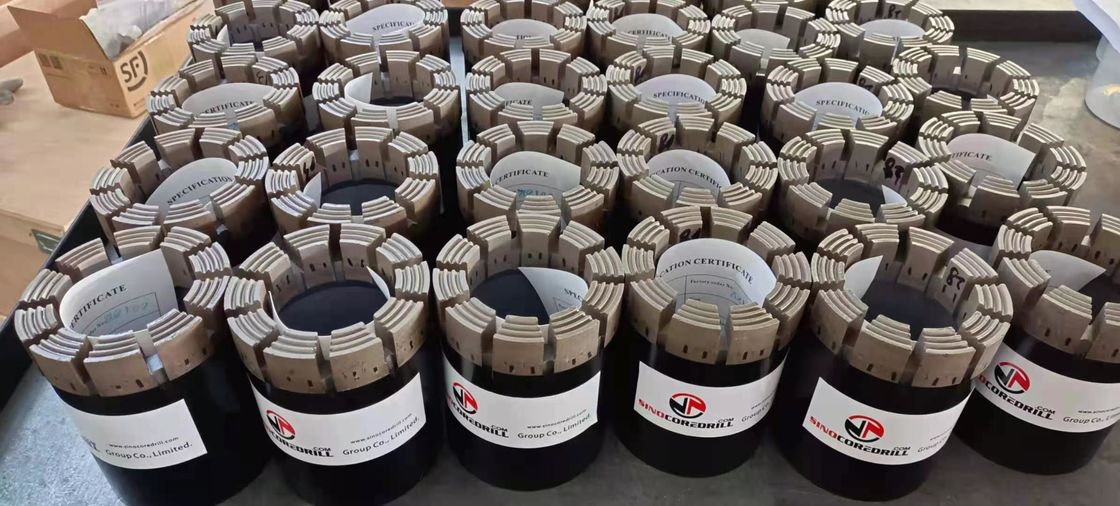HQWL 96MM 63.5MM Wireline Diamond Core Bits Series Hardness 1~14 ,Crown Height 14mm
HQ Diamond Core Bits for conventional double tube,Diamond core bits are widely used in the drilling for geological exploration,water conservancy and power engineering,hydro geological exploration and building construction,etc,Our double tube core bits from S1-S14 hardness suit for different rock dormation, Wholesaler AQ BQ NQ HQ PQ geological drilling tools impregnated diamond core drill bit.
We manufacture slight variances of the standard matrices to fine-tune the bits performance considering the drill rig capabilities and formations being encountered.
Features of Impregnated Diamond Bits
1. This diamond tool features with fast penetration rate, because the matrix of our impregnated diamond bits is specially designed (it is designed to expose new diamonds to the bits' cutting face as wear occurs).
2. Can help reduce the cost for diamond drilling: our impregnated diamond bits are manufactured to give optimum penetration rates and service life.
3. The hardness and abrasiveness of the formation to be drilled largely determined the optimum diamond size, concentration and matrix type, etc.
Bit Selection
When selecting a bit there are 3 main factors that contribute to decision making
○ Rock Hardness
○ Rock Formations
○ Bit Characteristics
• Rock Hardness
Measured using MOHS hardness scale: The Mohs scale of mineral hardness is a qualitative ordinal scale that characterizes the scratch resistance of various minerals through the ability of a harder material to scratch a softer material.
• Rock Formations
Rock types are classified by their different chemistry and structure. Hardness in theory is relative; therefore, soft rocks can prove more difficult to drill than hard rock. Also, the same rock formations, in different locations, can drill differently.
Factors that Determine Drillability
○ Grain Size
○ Rock Hardness
○ Weathering and Fracturing
• Bit Characteristics
Matrix – Each of the matrices has a different rate of wear. The matrix chosen is ideal when there is a balance between the wear of the matrix material and the diamonds exposing ensuring a high rate of penetration and optimum bit life.
Gauge – The outer (hole) and inner (core) dimensions of the bit
Crown Height – Ranging from 4mm to 14mm in height. With higher crowns available upon request. The height of the crown is chosen based of hole depth and wear rate.
Waterways – There are multiple different waterway configurations depending on the drilling conditions
Standard size of impregnated core bit
|
Double tube surface
|
|
Size( surface
exploration drill
|
Matric system(mm
|
Imperial system( in ) |
|
Hole diameter
|
Core diameter
|
Hole diameter
|
Core diameter
|
|
BQ
|
60
|
36.4
|
2.36
|
1.43
|
|
NQ
|
75.7
|
47.6
|
2.98
|
match1.88
|
|
HQ
|
96.1
|
63.5
|
3.match78
|
2.5
|
|
PQ
|
122.7
|
85
|
4.83
|
3.34
|
|
Triple tube surface
|
|
|
|
|
|
NQ3
|
75.7
|
45
|
2.98
|
1.78
|
|
HQ3
|
96.1
|
61.1
|
3.78
|
2.41
|
|
PQ3
|
122.7
|
83
|
4.83
|
3.27
|
Available Size for our Impregnated Diamond Bits
"Q" series:AQ,BQ,NQ,HQ,PQ/AQTK,BQTK,BQ3,NQ2,NQ3,NQTT,HQ3,HQTT,PQ3,PQTT
T2 series: T2 46,T2 56,T2 66,T2 76,T2 86,T2 101
T6 series: T6 76,T6 86,T6 101,T6 116,T6 131,T6 146, T6S 101,T6S 116
T series: T36,T46,T56,T66,T76,T86
Z series: Z46,Z56,Z66,Z76,Z86,Z101,Z116,Z131,Z146
B series: B36,B46,B56,B66,B76,B86,B101,B116,B131,B146
WF series: HWF,PWF,SWF,UWF,ZWF
WT series: RWT,EWT,AWT,BWT,NWT,HWT
WM series: EWM,AWM,BWM,NWM,HWM
WG series: EWG,AWG,BWG,NWG,HWG
Others: NMLC,HMLC,LTK48,LTK60,BGM,NGM,ADBG,TBW,TNW,
ATW,BTW,NTW,NXD3,AX,NX,NXC,AXT,T6H,4 9/16,NWD4,412F,SK6L146,
TT46,TB56,TS116,CHD101
Parameters Contributing to Drilling
• Fluid Velocity
Fluid flow is another critical variable in optimizing drilling efficiency. The fluid must effectively cool the bit and remove the cuttings from the bit face and then transport these cuttings up the annulus of the hole to the surface as efficiently as possible. Fluid volume should be increased as penetration rates increase. The velocity of the fluid and its carrying ability of the cuttings depend on the fluid viscosity. Generally, cuttings should always have an upward velocity of 4 in/sec. (10 cm/sec).
Too much fluid volume can cause hydraulic lift that seriously affects actual bit weight and consequently drilling performance. If the fluid flow is too low, the bit can wear prematurely due to the abrasive action of the cuttings. In very hard fine-grained formations, fluid velocity can be intentionally reduced to increase matrix erosion to expose new diamonds.
• String Stability
In all recommended operating parameters it is important to select a combination of RPM and Weight that minimizes or preferably eliminates drill string vibration.
Factors contributing to drill string vibration are:
• Misalignment of the drill string with the hole
• Operating within critical ranges of the drill string
• Excessive bit weight or rotation speed
• Bent core barrel or rods
• Oversize annulus
• Rotational Speed Relative to Penetration (RPI)
Optimum rotational speeds depend on the formation types being drilled and inter-relationship between the rig capabilities, peripheral equipment being used, and the individual drilling styles.
RPI (revolutions per inch) is singularly the most important factor to consider when trying optimizing bit life and productivity. It is a ratio of the rotational speed (rpm) to the penetration rate. (If the RPI is too low, premature diamond loss from the matrix is very likely. Conversely, if the RPI is too high, it is very likely that the diamonds will become polished and penetration rates will fall off.)
Maintaining a good RPI ensures that the diamonds stay exposed and that the bit wears at an even and controlled rate. Ideally, the RPI should be between 200 - 250 for all impregnated drill bits. Factors such as drill string vibration or rig constraints might prevent operating within an optimum RPI range, in which case a lower ratio should be used to optimize the bits performance under adverse drilling conditions.
• Bit Weight
The weight applied to the drill bit is the other important variable in optimizing bit life and achieving a desired RPI. The weight has to be sufficient to maintain a rate of advance relative to the rotational speed (to keep the bit penetrating), as indicated by the RPI factor. However, a weight that is too high can cause diamond re-impregnation or rapid wear due to stripping or even a mechanical failure of the matrix. Too low of a weight often leads to the diamonds becoming polished, requiring the matrix to be stripped to expose a new layer of diamonds.
Ideally, the matrix being used performs best when it wears at the same rate as the diamonds. If the matrix requires continues stripping to achieve an acceptable penetration rate, then a softer matrix (higher Hayden number) should be used.
As a guideline, the weight on an impregnated bit should never exceed 2000-2500 psi or (1378 N/cm²-1723 N/cm²).
Sharpening Techniques
If the bit becomes polished, glazed or dull. There are various techniques to sharpen the matrix and expose new diamonds.
• Reduce water flow
• Increase Drilling Pressure
• Increase Drilling Pressure and reduce water flow
• Reduce water flow and RPM
Bit Wear Patterns
The bit wear pattern is a good reference for operator to troubleshoot the problems through the given recommended resolutions. In accordance to drill's operating parameters recommendations and bit matrix / waterways specifications, the operators can simply alter configurations that is best suited to the ground condition





Q:Are you trading company or manufacturer ?
A: We are a specialized manufacturer.
Q: How long is your delivery time?
A: Generally it is 5-10 days if the goods are in stock. or it is 15-20 days if the goods are not in stock, it is according to quantity.
Q: What is your terms of payment ?
A: Payment<=1000USD, 100% in advance. Payment>=1000USD, 30% T/T in advance ,balance before shippment.
T/T, L/C, Western Union.
Q: What are your main products, and used for?
A: Our products include core bit, PDC bit, reaming shell, core barrel, casing, drill rod, drill rig and other drilling parts.
They are used for mineral exploration, geological drilling, geotechnical engineering and soil sampling.
Q: How about the delivery terms?
A: Min. order quantity: 1 piece. Transportation: By DHL/TNT/Fedex express, air, sea, train.
Q: How about discount?
A: Price is based on products and order quantity.
Q: Do you accept sample order?
A: Yes sure, please contact us for details.
Q: How about your after-sales service?
A: As a manufacturer, we offer promote technology support for all problems and questions. Besides, we accept goods return or replace for quality problem.
Q: Where is your factory located in?
A: Our factory is located in Jiangyin city,Jiangsu province, China.
Q: How does your company control the quality?
A: Quality first. In order to guarantee high quality for our products, Sinocoredrill usually makes a serious inspection for all products and raw materials in strict procedure

 Your message must be between 20-3,000 characters!
Your message must be between 20-3,000 characters! Please check your E-mail!
Please check your E-mail!  Your message must be between 20-3,000 characters!
Your message must be between 20-3,000 characters! Please check your E-mail!
Please check your E-mail! 



